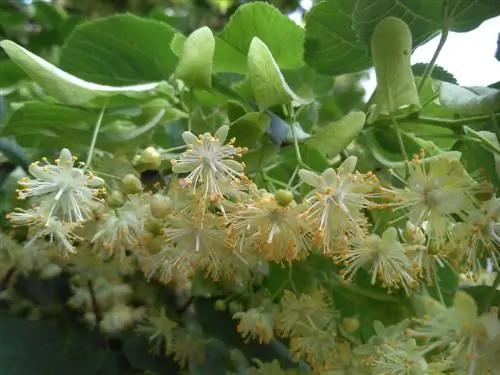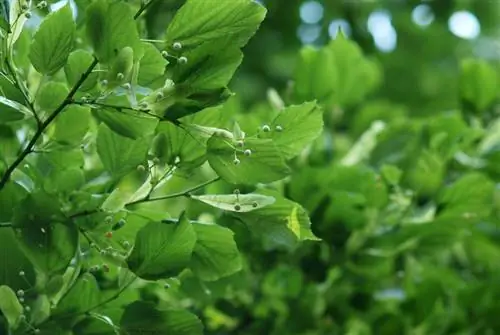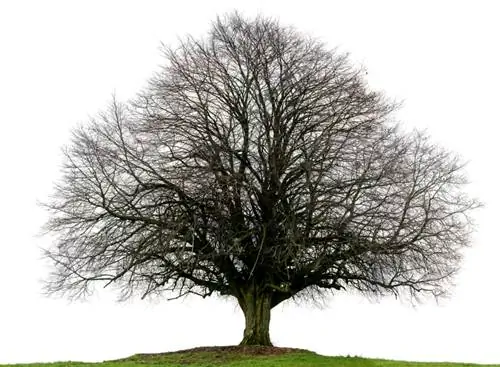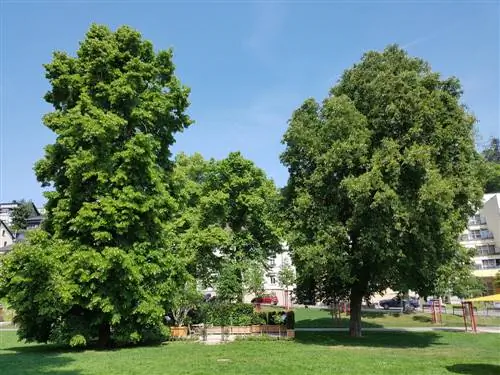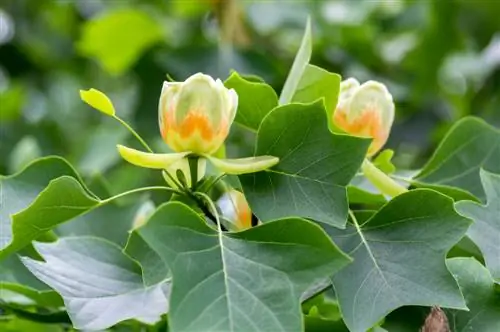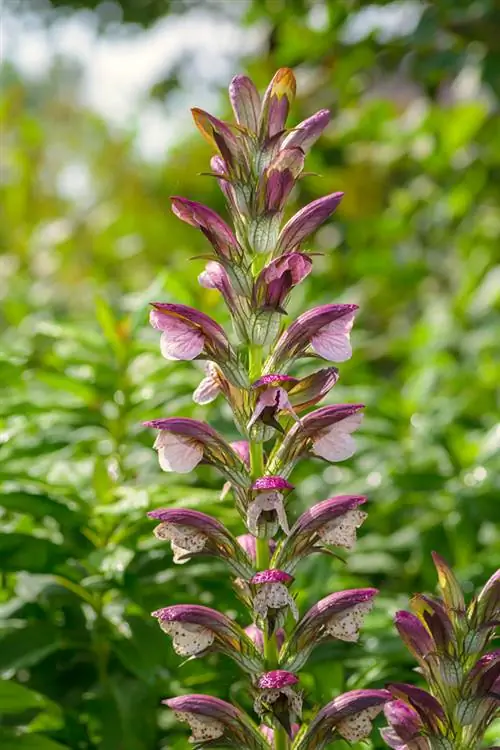- Author admin [email protected].
- Public 2023-12-16 16:46.
- Last modified 2025-01-23 11:22.
Read a commented summer linden tree profile here with information on leaves, flowers, fruit and location. Lots of tips on how to properly plant and professionally care for a Tilia platyphyllos.
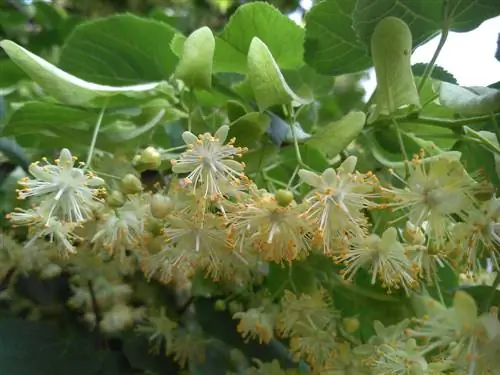
What are the characteristics of a summer linden tree?
The summer linden tree (Tilia platyphyllos) is a large deciduous tree that occurs in central and southern Europe. It has dark green, rounded leaves and light yellow, fragrant flowers that appear in June. The fruit is a nut and ripens in autumn. Summer linden trees are suitable as park, house, avenue or hedge trees and represent symbolic values in culture.
Profile
-
Scientific name:
Total Tilia platyphyllos - Family: Mallow family (Malvaceae)
- Occurrence: Central and Southern Europe
- Growth type: deciduous tree
- Growth height: 30 m to 40 m
- Leaf: summer green, roundish-ovoid
- Flowering: umbels
- Flowering time: June
- Fruit: Nut Fruit
- Bark: cracked
- Wood: soft, easy to cut
- Use: park tree, privacy screen, hedge, medicinal plant
Video: Summer linden tree in portrait
Leaf
The steeply rising branches of the dome-shaped summer linden tree crown have a dense foliage that provides pleasant shade. The alternate leaves hang close together on the long petiole. The picturesque deciduous tree is often also called the large-leaved linden tree. You can recognize a summer linden tree leaf by these characteristics:
- Blooming: in early spring from narrow, pointed buds
- Leaf shape: asymmetrical, roundish-ovoid to heart-shaped with a distinctive, slender tip
- Leaf size: 10 cm to 15 cm on the 3 cm to 5 cm long stem
- Leaf edge: sawn, finely toothed (teeth point towards the tip of the leaf)
- Leaf color: dark green, leaf veins on the underside with white hairs
- Autumn color: yellow
Bloom
When the summer linden tree blooms in June, the air is filled with the intense scent of honey. Even from afar, day and night, you can hear the lively humming and humming of busy insects harvesting the sugary sweet nectar. The summer linden tree has been revered as a symbol of life since the Middle Ages and to this day marks the center of cultural life in rural regions as the village linden tree. Up to 40,000 flowers with these characteristics gather in a crown:
- flower ecology: hermaphrodite
- Flower shape: umbellate (3 to 6 individual flowers), hanging
- Flower color: light yellow
- Single flower: 12 mm to 14 mm with greenish-white bract and up to 40 stamens
- Pollinators: bees, bumblebees and moths
- Special feature: high sugar value of up to 7.7 mg sugar per day and flower
Linden blossoms are said to have natural healing properties. As early as the 17th century, herbalists recognized the diaphoretic and calming effects of lime blossom tea. Furthermore, the summer linden tree is an important bee pasture as a rich source of nectar and pollen.
Fruit
The summer linden tree sends its seeds on their journey, well packaged in a capsule. In autumn, the fruits sail through parks and forests like little helicopters, much to the delight of hikers young and old. These botanical attributes characterize the fruit of a summer linden tree:
- Category: Nut fruit, collected fruit
- Fruit stand: one to two seeded nuts in groups with 5 to 7 individual fruits
- Fruit ripeness: September
- Special feature: Rotorcraft with a bract as a wing for wind dispersal (nose sweeper)
The spherical fruits are hairy and 8 mm to 10 mm large. Before winter, the hard-shelled fruits release their seeds because a winter cold stimulus is necessary for germination.
Bark
The bark on the upright trunk is dark gray to brownish in color. Over time, the bark undergoes a transformation. In youth, narrow cracks characterize the appearance. On an old summer linden tree, the bark has deep furrows and is peeling off in places.
Wood
The wood of the summer linden tree does not differ from the wood of other European linden species, such as a Dutch linden tree (Tilia europaea) or winter linden tree (Tilia cordata). Linden wood is soft, easy to work with and can be easily planed or cut. The wood is mainly used in sculpture, wood turning and carving. Famous late Gothic works of art were predominantly made from lime wood. Today the wood is used in a variety of ways in the construction of musical instruments. Harps, piano keys, organ pipe reeds or the sound bodies of guitars and bass violins are often made of lime wood.
Excursus
Summer linden tree Winter linden tree difference
To reliably distinguish between summer linden and winter linden trees, take a close look at the leaves, flowers and fruits of both types of linden trees. A summer linden tree has significantly larger, dark green leaves with light green, white hairy undersides. The smaller, shiny green winter linden leaves have blue-green and rusty-red hairs underneath. The fragrant umbels of a summer linden tree consist of 4 to 6 individual flowers. A winter linden tree blooms with 4 to 12 individual flowers per umbel. A summer linden tree fruit is hard. In contrast, you can easily crush the fruits of a winter linden tree.
Planting summer lime tree
You can buy and plant summer linden trees all year round as pots and bales. Inexpensive, bare-root Heister are usually available from mid-October and are best planted before the first frost. For use as a house tree, privacy screen, fence or bee pasture, the right location at the appropriate planting distance is important. Read these useful tips to help you plant a summer linden tree correctly:
Location
These light and soil conditions are optimal for a summer lime tree in top form:
- Sunny to partially shaded.
- Warm and protected from the wind without risk of late frost.
- Fresh to moist garden soil, permeable and deep.
- Nutrient-rich soil with a pH between 6 and 7.
Planting spacing
As a representative solitaire, the summer linden tree wants a sufficient distance from neighboring plants and buildings. Casting shadows is fatal for the light tree species and results in a deformity of the crown. If the type of linden tree serves as a privacy screen, the correct planting distance determines whether the young plants form a complete hedge. The following table provides an overview:
| Usage | Planting spacing |
|---|---|
| Park tree (uncut) | 15 m to 20 m |
| House tree (pruned regularly) | 10 m to 15 m |
| Avenue/Street Tree | 2 m to 4 m (to the street) |
| Hedge (80 cm high potted product) | 25 cm to 30 cm |
| Hedge (150 cm high heister) | 50 cm to 60 cm |
The prescribed distance between a summer linden tree and the property line can be found in the neighborhood law of your federal state. The rule of thumb for Germany is that trees with a height of 2 meters or more must maintain a minimum distance of 2 to 3 meters from the neighboring property. Considering a crown extension of up to 20 meters, this value is of course limited.
Planting summer lime tree
The right planting technique paves the way for a magnificent summer linden tree. Important planting tips for Tilia platyphyllos in a nutshell:
- Planting pit size: double the volume of the root ball.
- Start fertilization: Enrich the excavation by a third with compost and horn shavings.
- Soak roots: place potted and bare-rooted products in water until no more air bubbles appear.
- Planting depth: Maintain previous planting depth (pay attention to the soil mark on the trunk).
- Supports: drive in a wooden post next to the deciduous tree and attach it to the trunk with hose ties.
- Watering: water regularly and abundantly on the day of planting and in the following weeks.
After planting in autumn, please mulch the root disc with leaves and spruce branches.
Care for the summer lime tree
The summer linden tree is easy to care for. The cornerstone of the simple care program is a needs-based supply of water and nutrients. The extent of pruning care depends on how it is used. This is how you care for Tilia platyphyllos in an exemplary manner:
Pouring
In the year of planting and in the following three to four years, please water a young summer linden tree when the summer is dry. Let the water hose run in the morning or evening until the first puddles form on the root disk. Older specimens have developed a vital cardiac root system with a deep taproot and are content with normal rainfall.
Fertilize
Give growth a boost in spring with a generous portion of compost. Distribute 3 liters of ripe compost soil and 100 grams of horn shavings on the tree disc. Rake in the organic fertilizer superficially and water again. By spraying the root disc with potassium-rich comfrey manure in August and September, you can naturally strengthen the winter hardiness of your summer lime tree.
Cutting
The summer linden tree is one of the tree species that tolerates pruning. You cut an impressive solitaire less often than a hedge. Don't miss these tips for perfect cut care:
- Tree trimming: every 2 to 3 years, thin out the crown in February, shorten branches that are too deep or too long at the end of June.
- Cutting hedges: extensive shape and maintenance pruning in the winter half of the year, corrective care pruning at the end of June.
- Removing shoots: tear off unwanted shoots from the root runners with a courageous tug.
The good-natured pruning tolerance of European lime tree species also allows radical rejuvenation pruning into old wood. Creative hobby gardeners like to grow summer linden trees as topiaries on tall trellises.
Popular varieties
Magnificent summer linden trees can be discovered in multi-faceted varieties in tree nurseries and garden centers:
- Örebro: garden-suitable, Swedish variety with a height of 15 m to 18 m for a sunny to semi-shady location.
- Fastigiata: slender summer lime tree with a height of 8 m to 10 m and a growth width of 3 m to 4 m.
- Rubra: colorful variety with coral red branches, yellow flowers and dark green foliage, up to 35 m high and 20 m wide.
- Pannonia: Large-leaved summer linden tree, in the ideal location with a spherical crown, 10 m tall and 3 m wide.
FAQ
From a gardening perspective, what is the difference between summer linden tree and winter linden tree?
The summer linden tree grows to an average height of 35 meters and 20 meters wide. With an annual growth of 40 to 60 centimeters, it is one of the fastest growing tree species. Tilia platyphyllos sprouts early, loves warmth and tolerates pruning well. The deciduous tree thrives best in fresh, moist, nutrient-rich and deep soil. A winter linden tree remains significantly smaller at 25 meters high and 12 meters wide, with an annual growth of around 30 centimeters. Tilia cordata is less demanding and grows well even in sandy, dry soil.
How is lime blossom tea prepared?
To prepare a cup, pour 150 milliliters of boiling hot water over a teaspoon (approx. 2 g) of lime blossoms. Cover and let the infusion steep for eight minutes. Now strain out the remaining flowers and enjoy the aromatic lime blossom tea sip by sip
What do linden blossoms look like?
The inflorescence of a linden tree is made up of several individual flowers that come together to form a hanging umbel. A single linden flower is about 12 mm tall and unfolds with five sepals and five petals that are yellowish-white in color. This double perianth frames numerous stamens. In addition, there is a greenish-white bract on each lime blossom.

